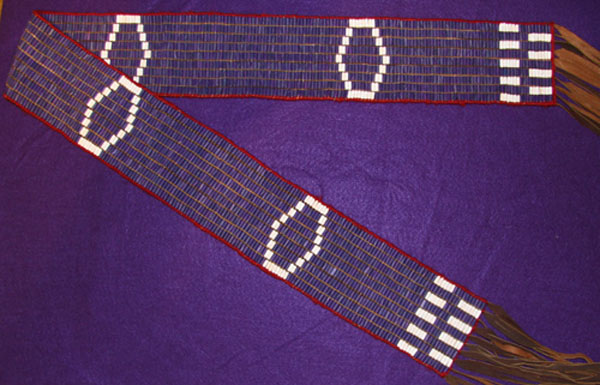 |
Photographs (left to right): All Photographs: Niagara Falls Butterfly Conservatory, Ontario, Canada
Wampum Belt Archive
Johnson Dish Belt

Photograph: Tehanetorens (1999)

Reproduction by Rich Hamell Oct. 10 2013
Original Size: |
Rows: 9. Length: 95 cm. 37.4 inches |
Reproduction: |
Beaded Length: 54.0 inches. Width: 4.25 inches; W/fringe: 78.0 inches |
Beads: |
Length: 318 rows by 9 rows wide. Total Beads: 2,862. |
Materials: |
Warp: Leather. Weft: Artificial Sinew. Edges wrap with Red Heart Acrylic. |
Description:
The belt is a reproduction of the ones commissioned by British Indian Agent Sir William Johnson. He had it presented to several Indian Nations during the mid-1750s in hopes of gaining their allegiance.
Native Americans were not the only group to use wampum belts. Europeans frequently used them to communicate with the Indians. This belt represents a promise by Johnson to provide war supplies and food to any group who would fight with the English against the French and their Indian allies.
The purple background emphasizes the importance of the message as the red border calls attention to the "life force" that the British were offering.
White hexagons represent the places (Johnson Hall, Fort Stanwix, Fort Oswego, and Fort Albany) where Indians could go to pick up the promised goods.
White bars at either end reveal that the French and their Indian allies are excluded from this offer.
National Battlefield Park at Fort Necessity has a similar reproduction made by Bob Winters.
Reference:
Beauchamp, William M. 1901. Wampum and Shell Articles Used By The New York Indians. New York State Museum Bulletin No. 41, Vol. 8.
Stolle, Nickolaus. 2016. Talking Beads: The history of wampum as a value and knowledge bearer, from its very first beginnings until today. Hamburg, Germany. ISSN 1437-7837
Tehanetorens. 1999. Wampum Belts of the Iroquois. Book Publishing Company, Summertown, TN.
 |
 |
 |
 |
 |
 |
 |
 |
|---|